Understanding how to make stocks and sauces is part of the essential knowledge of cooking. When you boil any ingredients in water, flavours from those ingredients get into the water. This is the reason for this.
If you do this because you want to cook the ingredient, a stock is created by itself in the liquid, which takes on the flavours (in French: a fond).
However, you can also have the sole aim of bringing the flavour from the ingredients into the liquid to make your own ingredient out of it, such as a sauce.
This is a science and an art that we will explain in many posts and step by step.
At this point, just briefly: Any liquid that has absorbed flavour can be intensified. For example, you can turn a stock into a jus, a strong sauce. Further concentration leads to a demi-glace and finally to a glace. These are intense, almost solid seasonings that can be used to give dishes depth of flavour.
Today (and in fact since yesterday) we are making a consommé double, an intensified beef stock that makes its own dish.
You can also make a consommé with other types of meat, mixtures of them and, of course, without any animal products at all – but that’s for another time.
We would like to make about a litre of consommé as part of a menu for 6 people.
That’s quite a lot, but making such stocks, boullions etc. always requires a certain amount of effort, which is why it makes sense to produce a good quantity right away and freeze the leftovers. Having such sources of flavour in the house catapults one’s own kitchen into completely different regions and makes spontaneous cooking of great dishes quite easy.
We start with a good kilo of meat bones, a beef shank of about 400 grams and soup vegetables: celeriac, carrot and leek, 400 grams each or more.
We had one parsnip left over, so that goes into the broth, too.
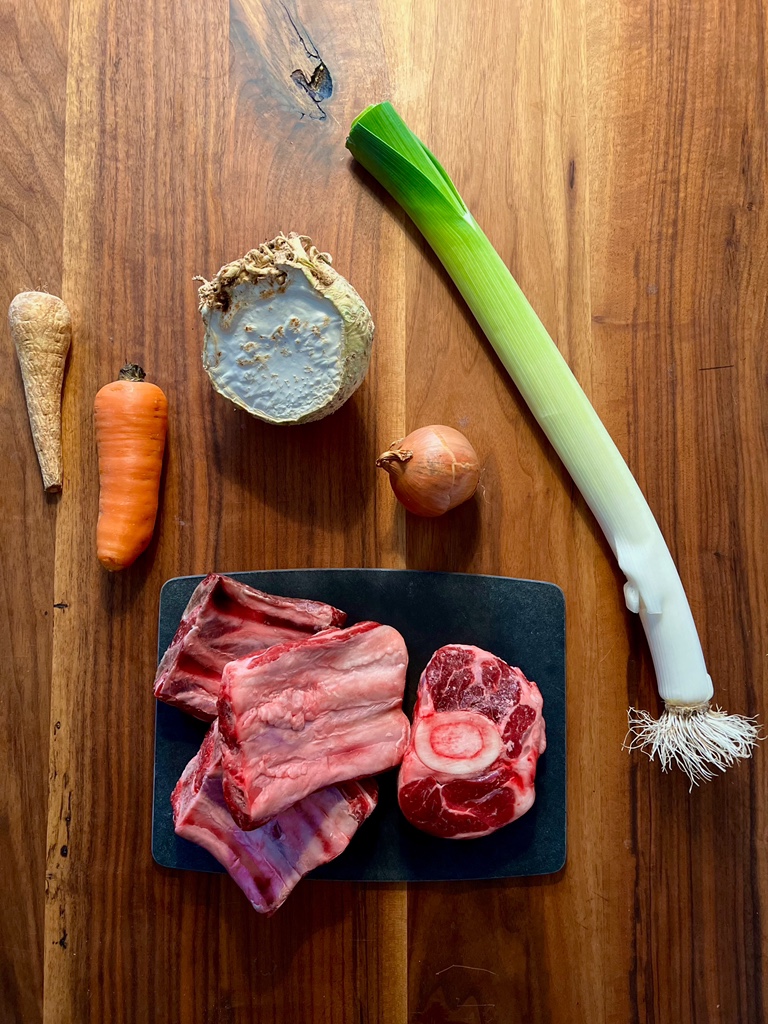
We cut the onion in half and heat it strongly in a pan without any fat to roast it until almost black. This, together with the peel of the onion, gives the stock not only flavour but also its golden colour.
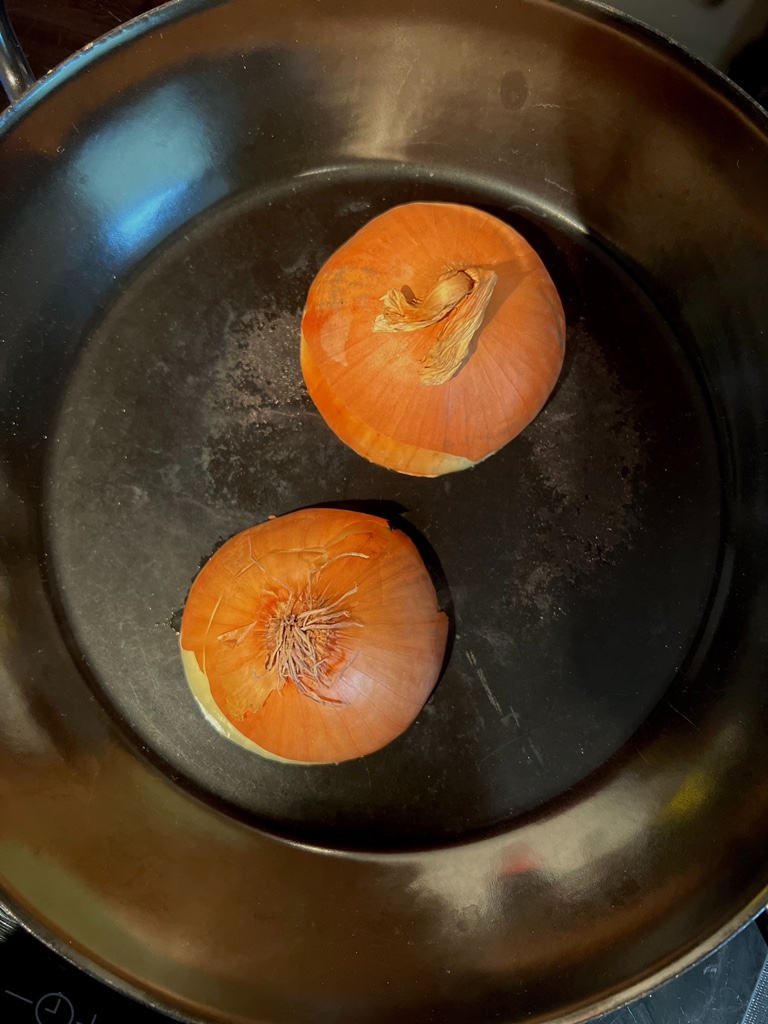
We put the meat in the largest of our pots and cover it with water, which we bring to the boil once.
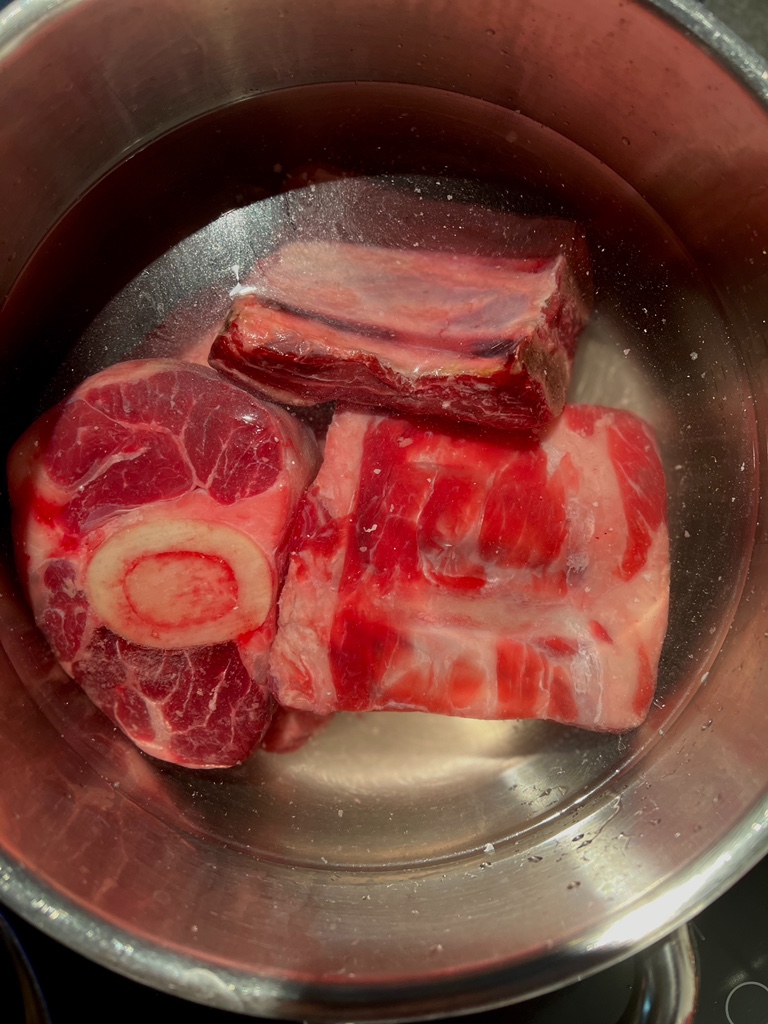
Meanwhile, the onions are prepared.
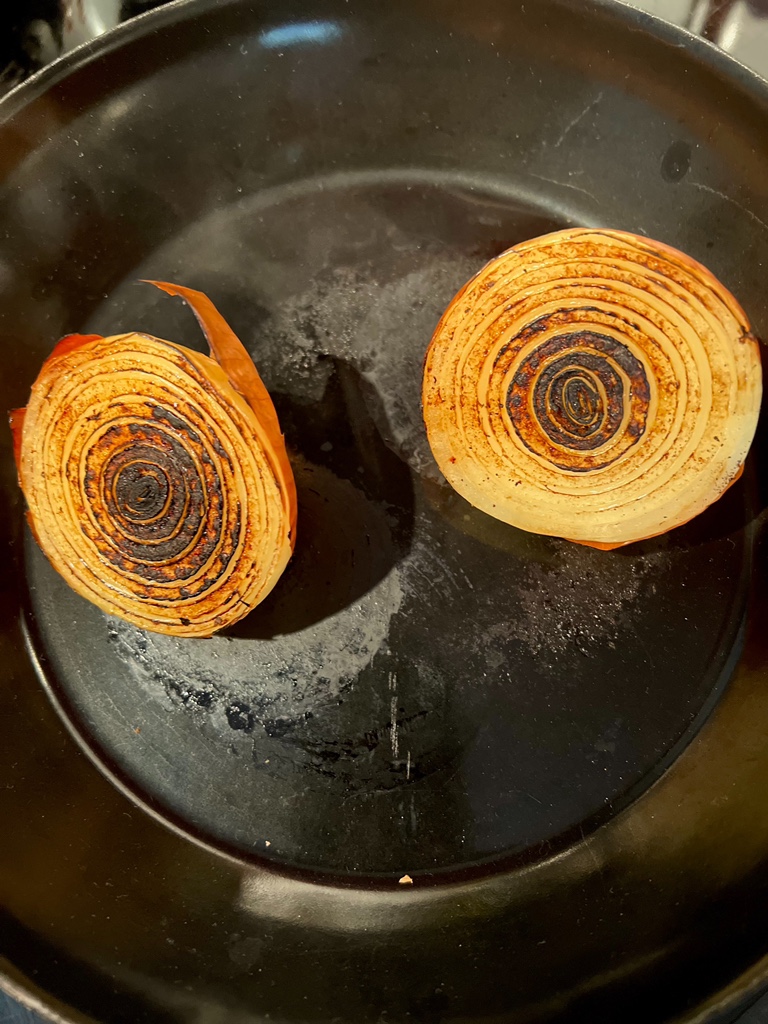
When the water boils, the meat has turned a grey colour and formed a lot of foam. This comes from the fat and all the things we don’t want in our food later.
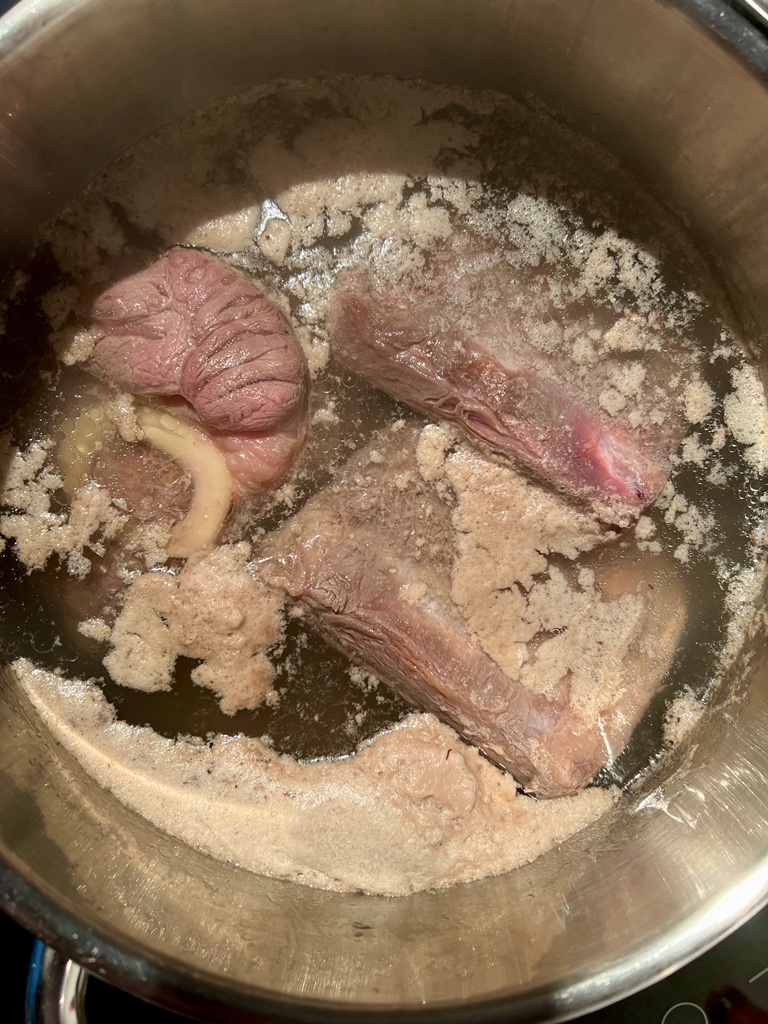
We pour it all off immediately and rinse the meat with clear water. The pot must also be washed out.
Please remember: This step is indispensable!
Then we put the meat with the blackened onion halves back into the pot and add 3 litres of cold water.
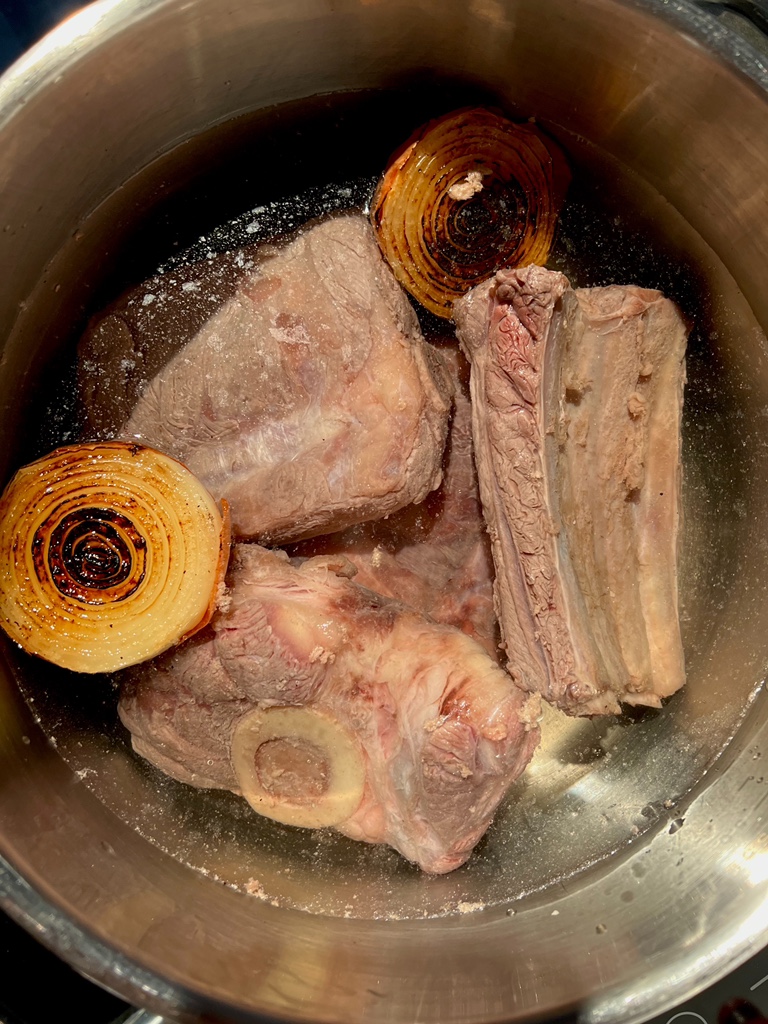
Very important: The water must be cold and only then heated to extract the maximum flavour. It must also NOT BE SALTED under any circumstances. Again, this is the reason.
We now let the stock simmer very gently for at least 2 hours (preferably 3), without a lid, so that some of the liquid evaporates and the flavour is concentrated. This is called reducing.
We prepare spices. As always, many things are possible, we decide on two bay leaves, a clove, some juniper berries and peppercorns. There are many types of pepper, black pepper would be the classic. We’re using cubeb pepper today because it’s around. We also add – not classically French – some coriander seeds.
Also not classic is the addition of a dried shiitake mushroom. We love the extra umami flavour it brings.
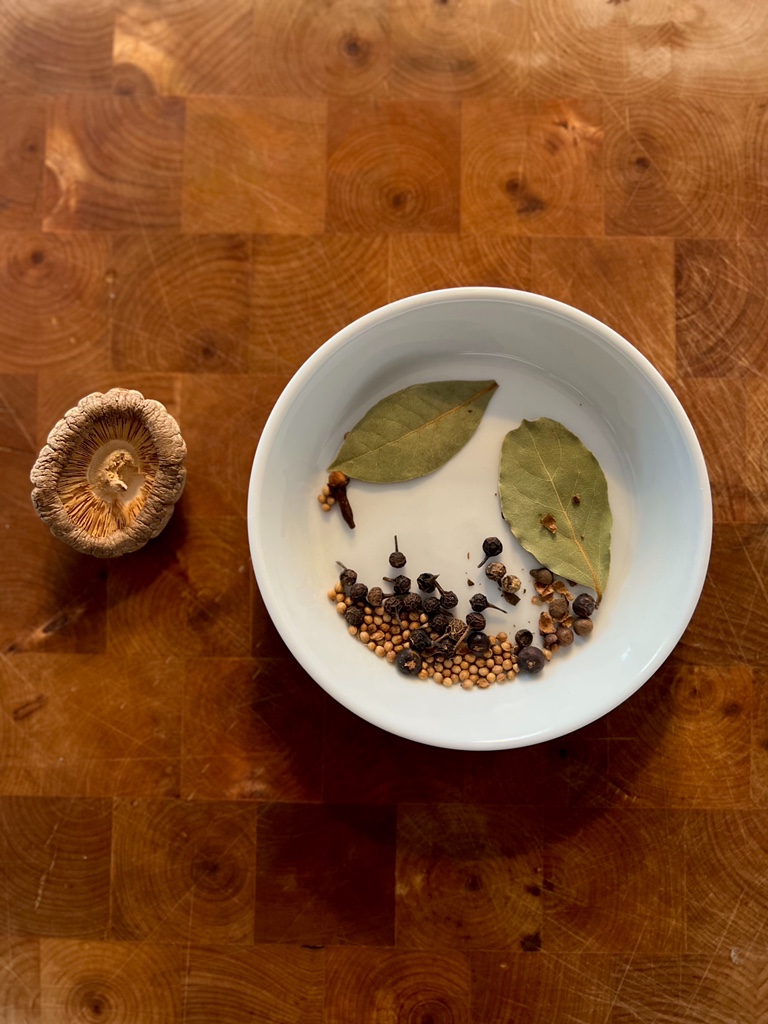
We wash the soup vegetables briefly and roughly dice half of them, including the peel. It will be removed later, so it’s not about optics or haptics, but only about maximum taste.
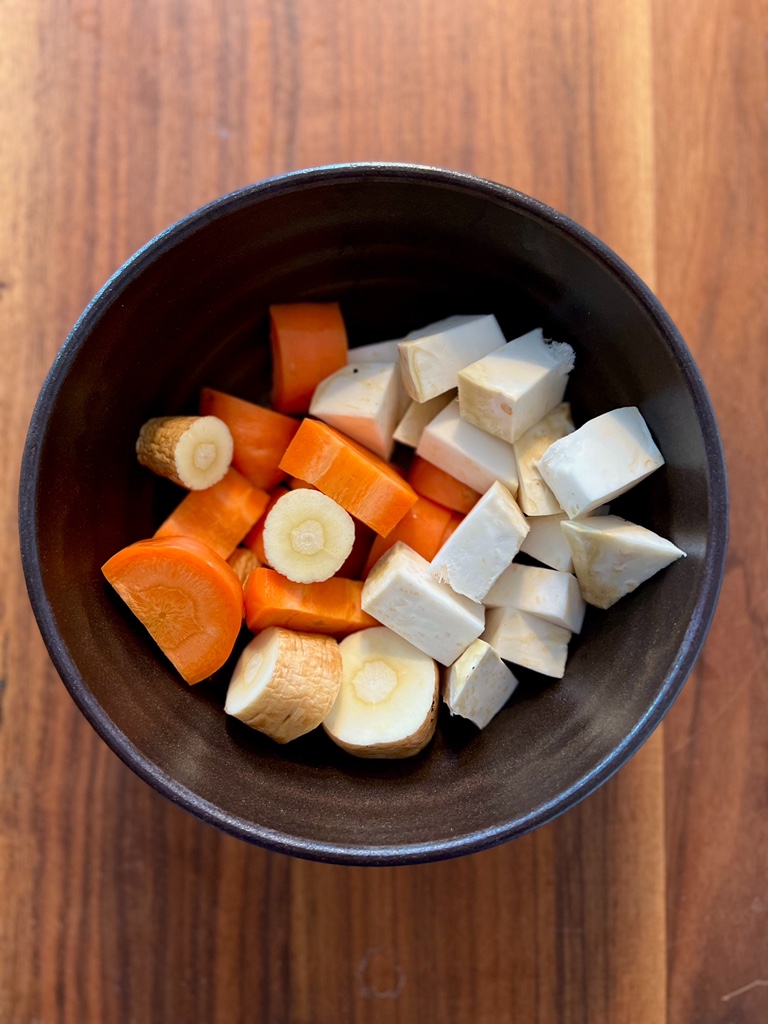
There is always some dirt in a leek towards the upper end. You learn the easiest way to remove it from Jacques Pépin.
We cut the leek once lengthwise from the transition from white to green.
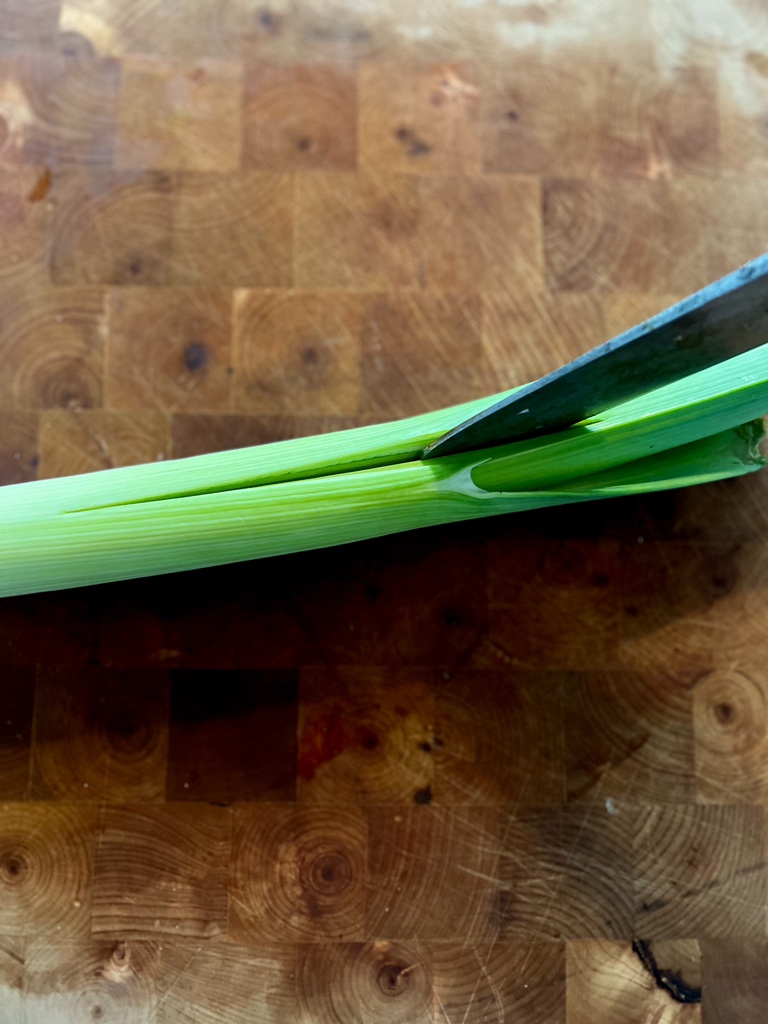
Then we do the same again, after a turn of 90 degrees.
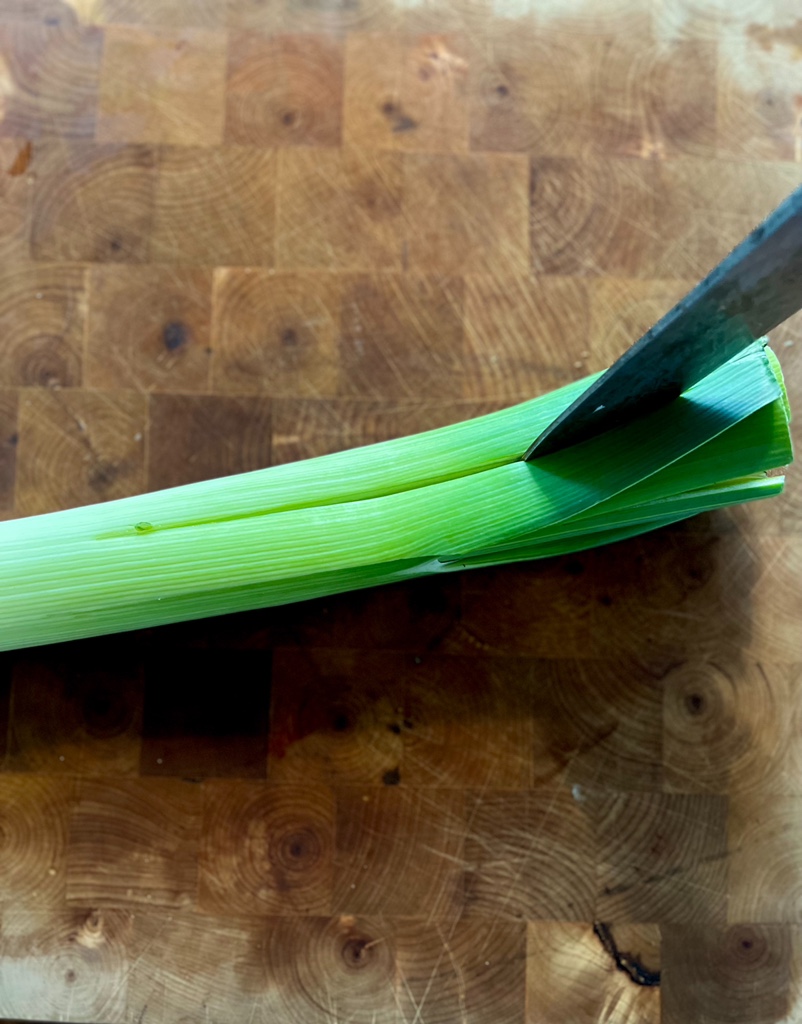
The leeks now finely fans out and can be washed easily.
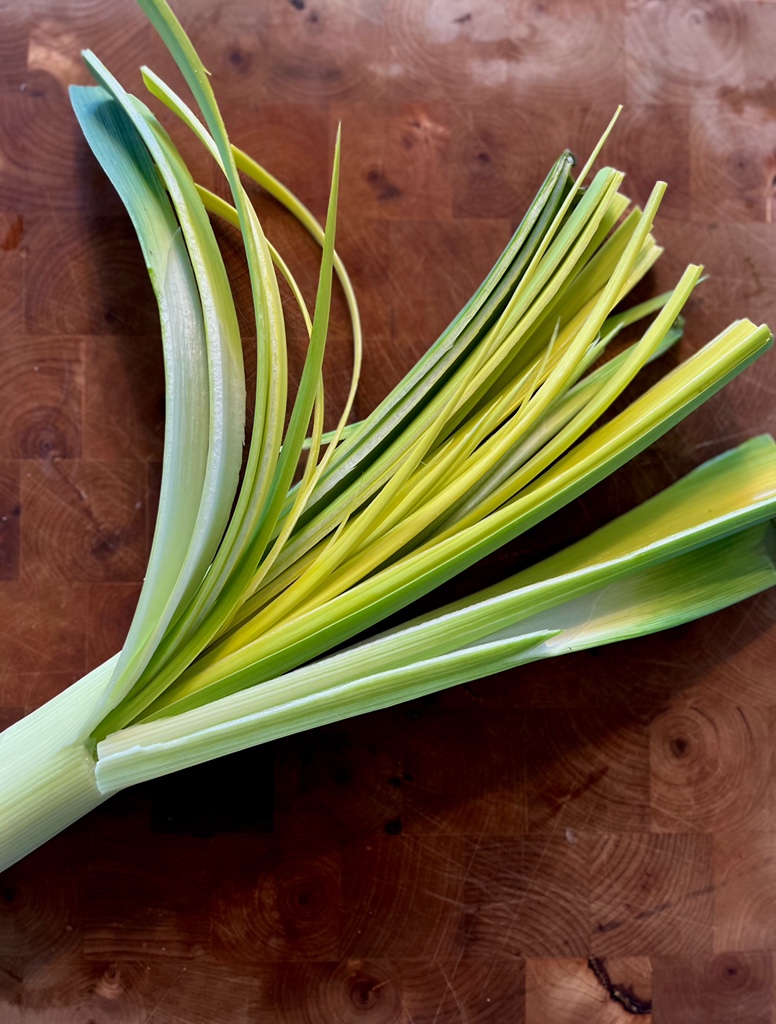
Now we also cut the green part of the leek into coarse pieces. We keep the rest for later.
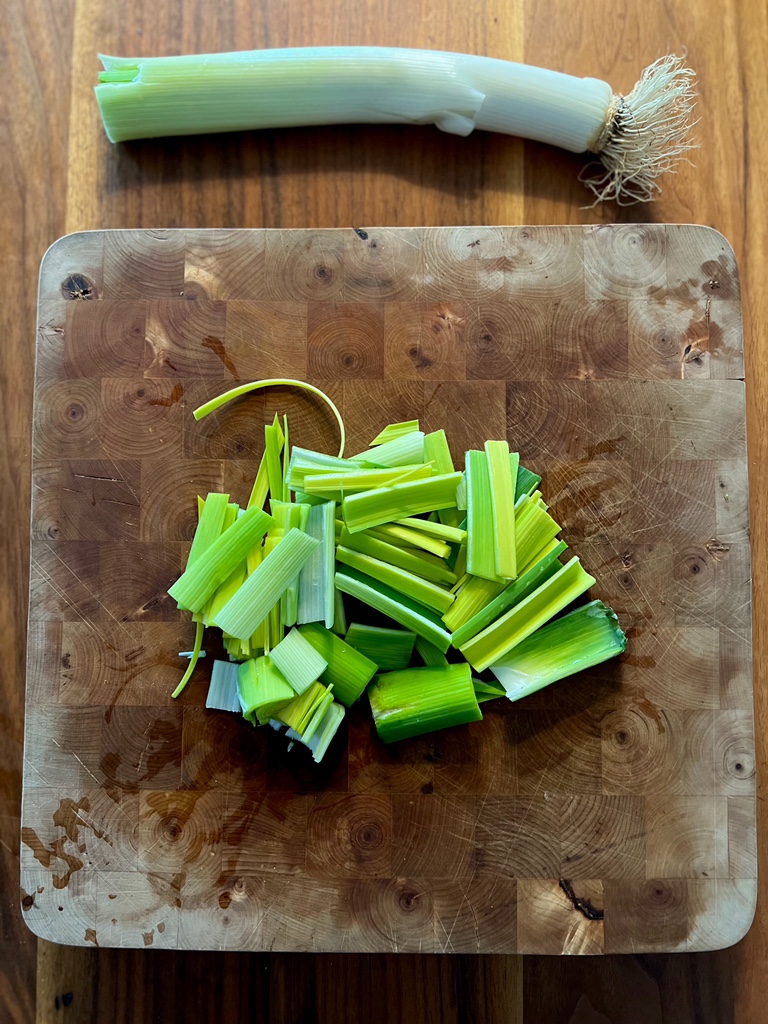
After 3 hours of gentle simmering, our stock looks like this:
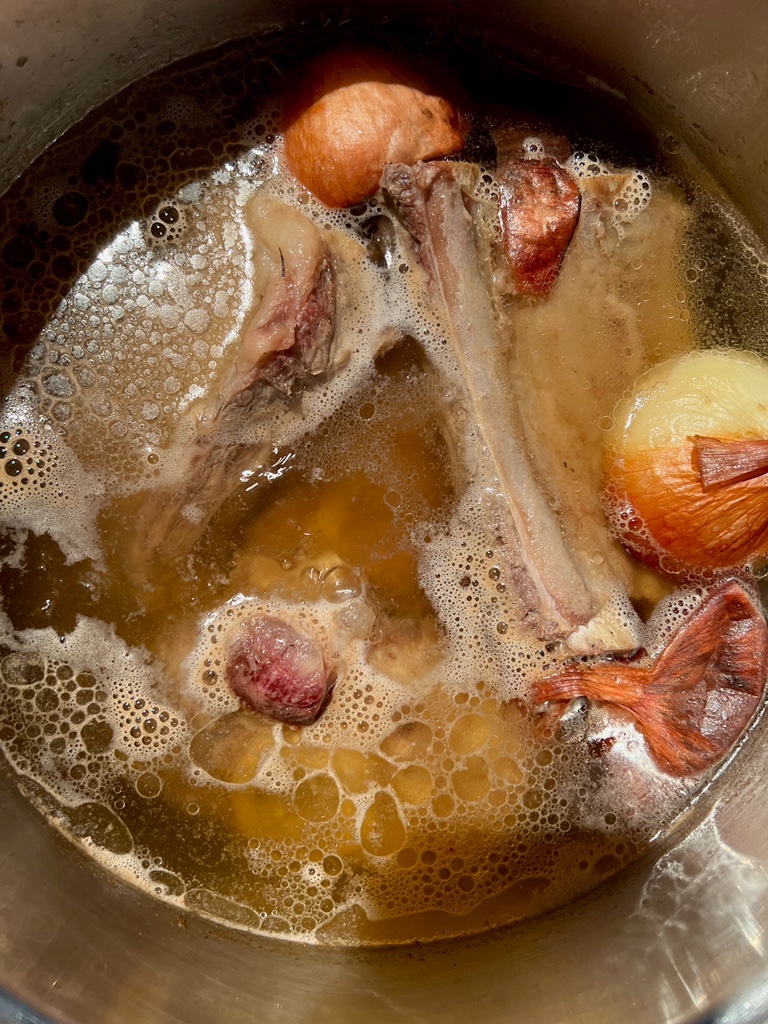
We add our spices and let the stock simmer for another hour.
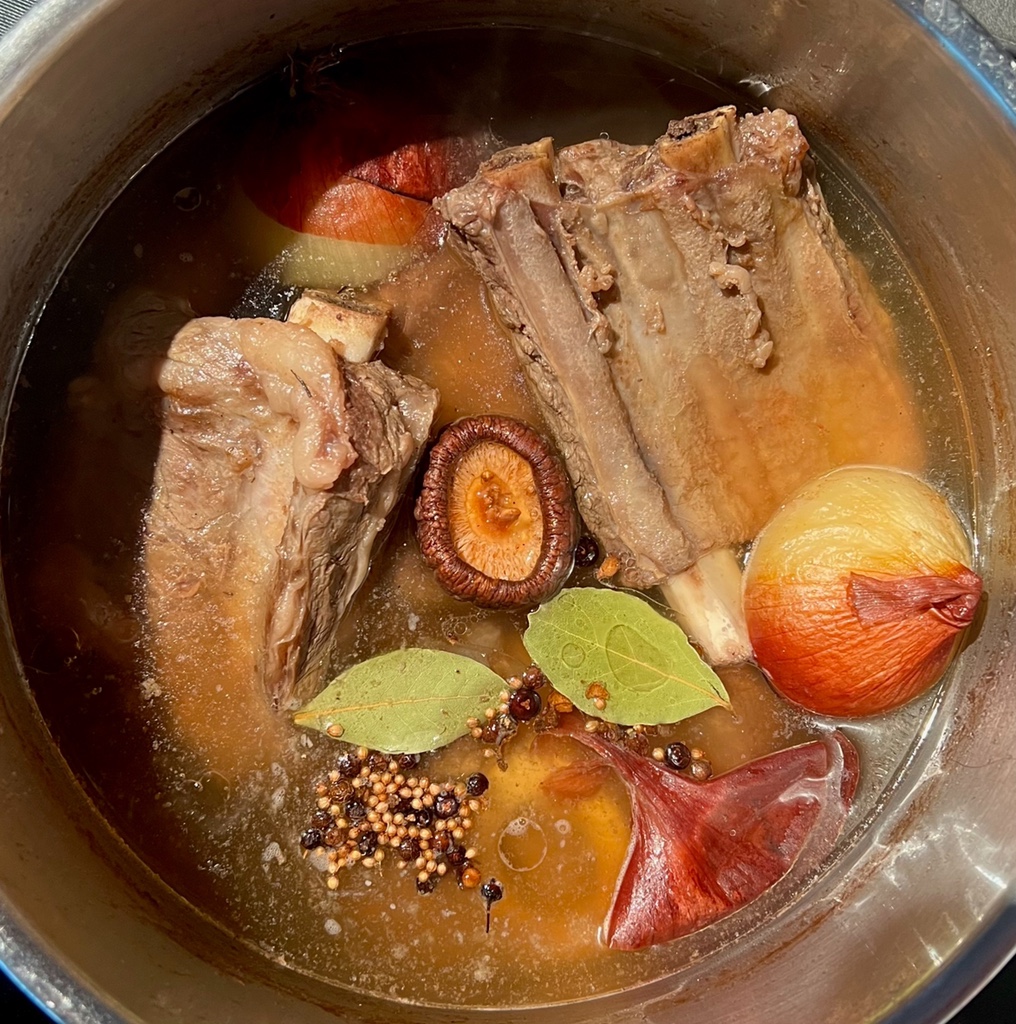
Finally, we add our vegetables and give the stock one last hour.
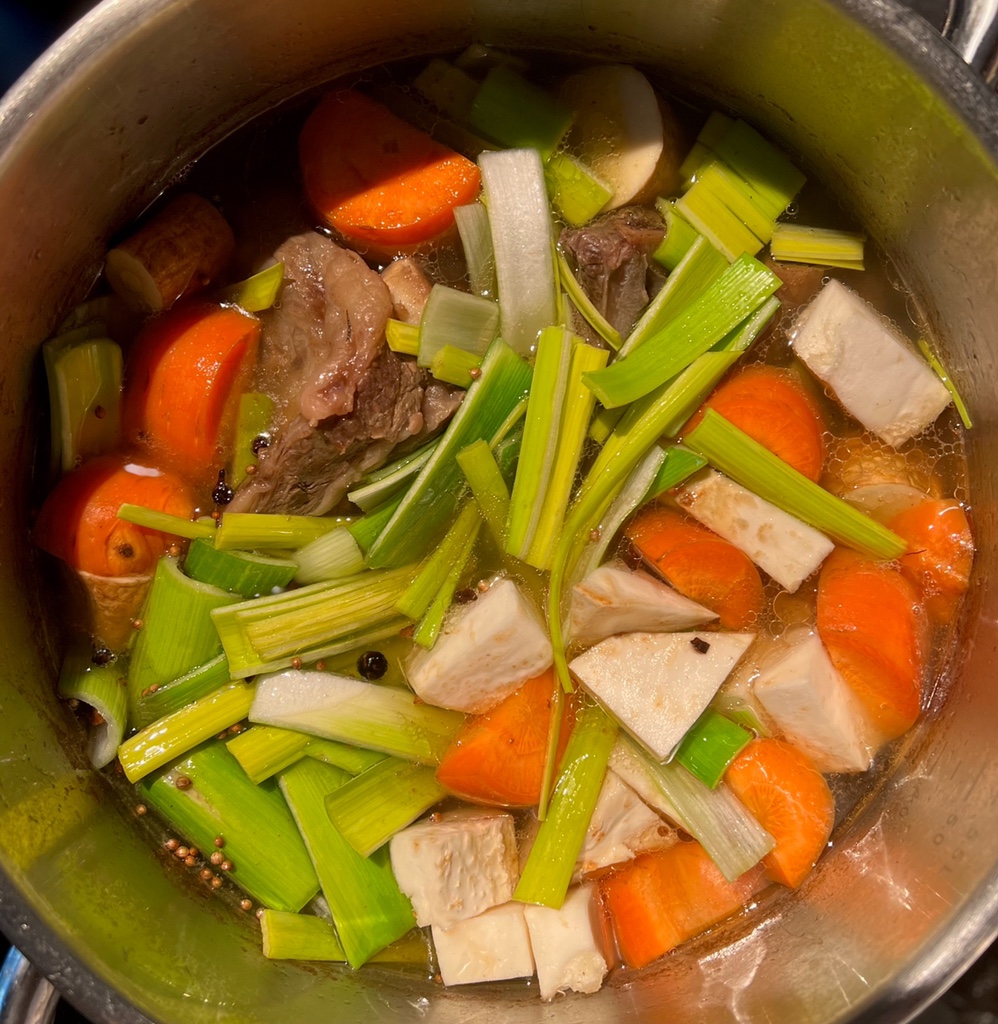
At the end of the process – 5 hours for us today – it looks like this:
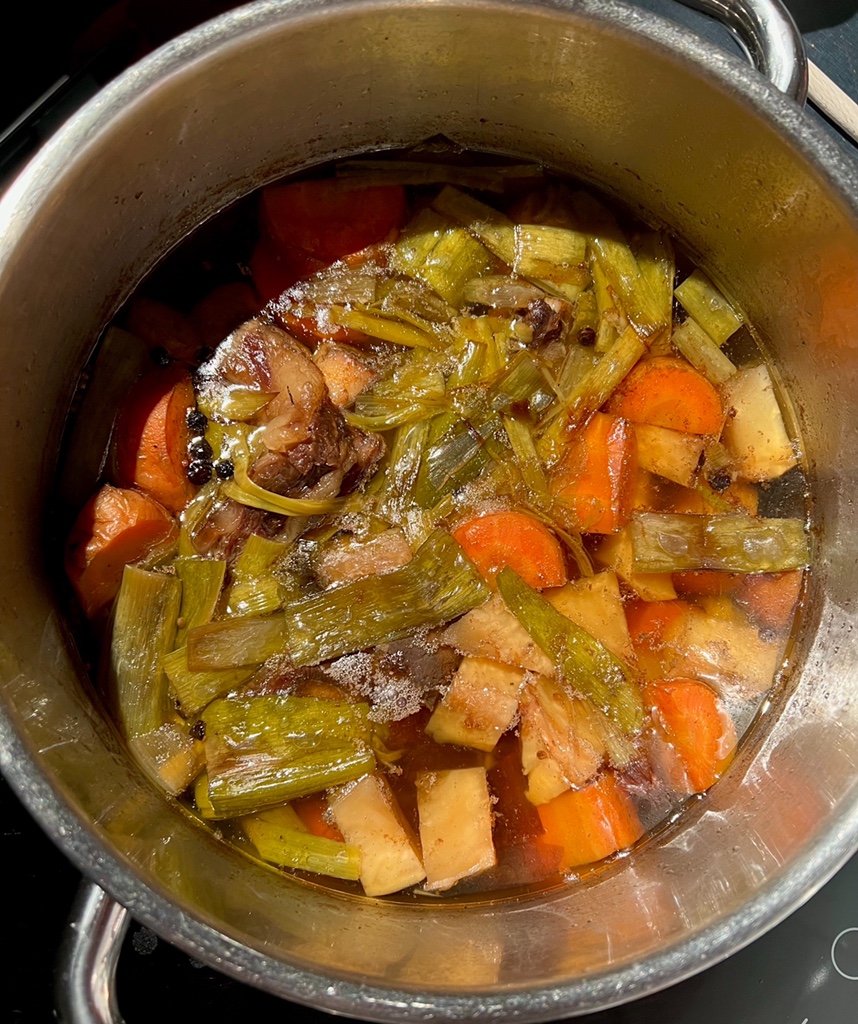
What you should have in your kitchen is a pointed sieve. Especially when you want to strain bones or large pieces of meat or vegetables, it is an indispensable tool. It sits deep in the vessel that is to hold the liquid, so nothing goes astray.
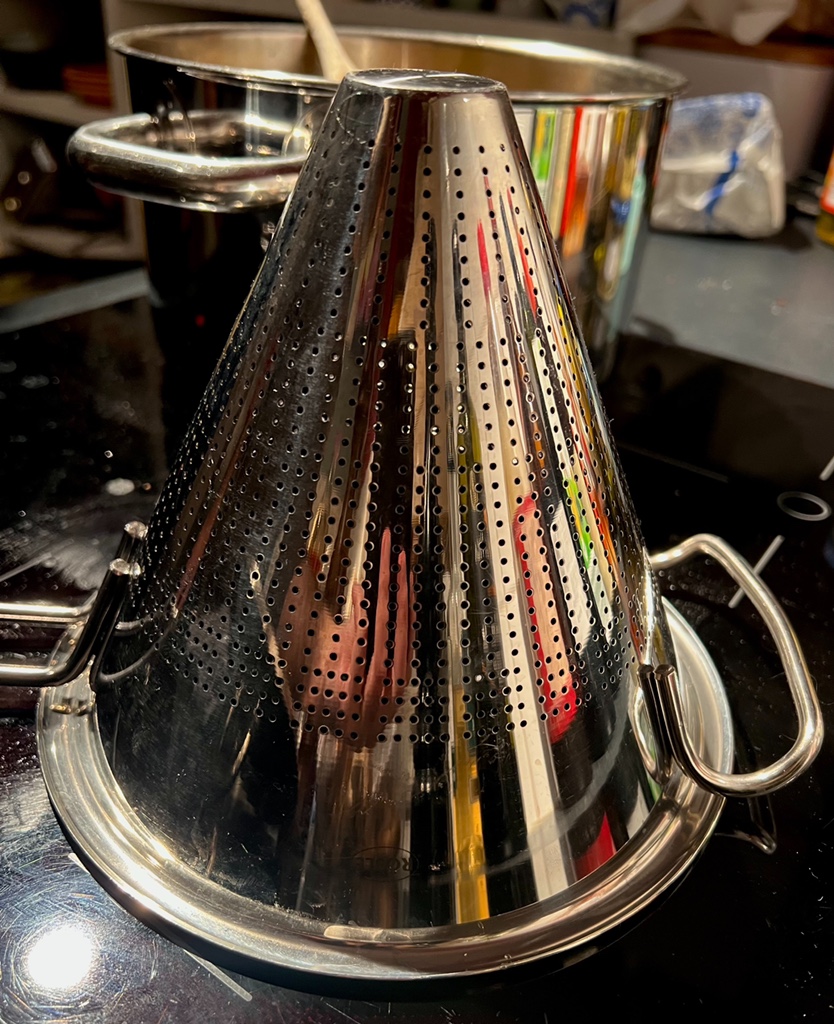
We separate the stock from the ingredients through the pointed sieve and squeeze the vegetables well with a cooking ladle – don’t waste anything!
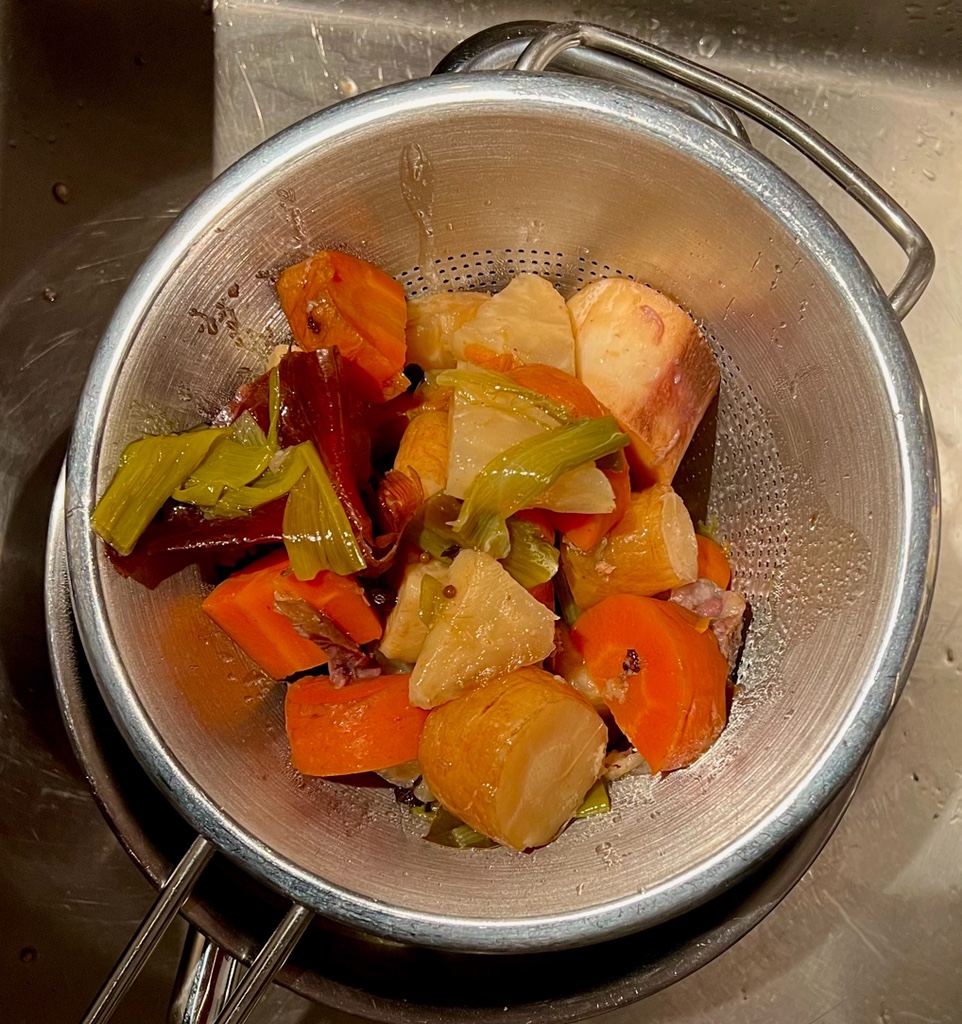
The result is about 1.5 litres of stock, which now has to cool down.
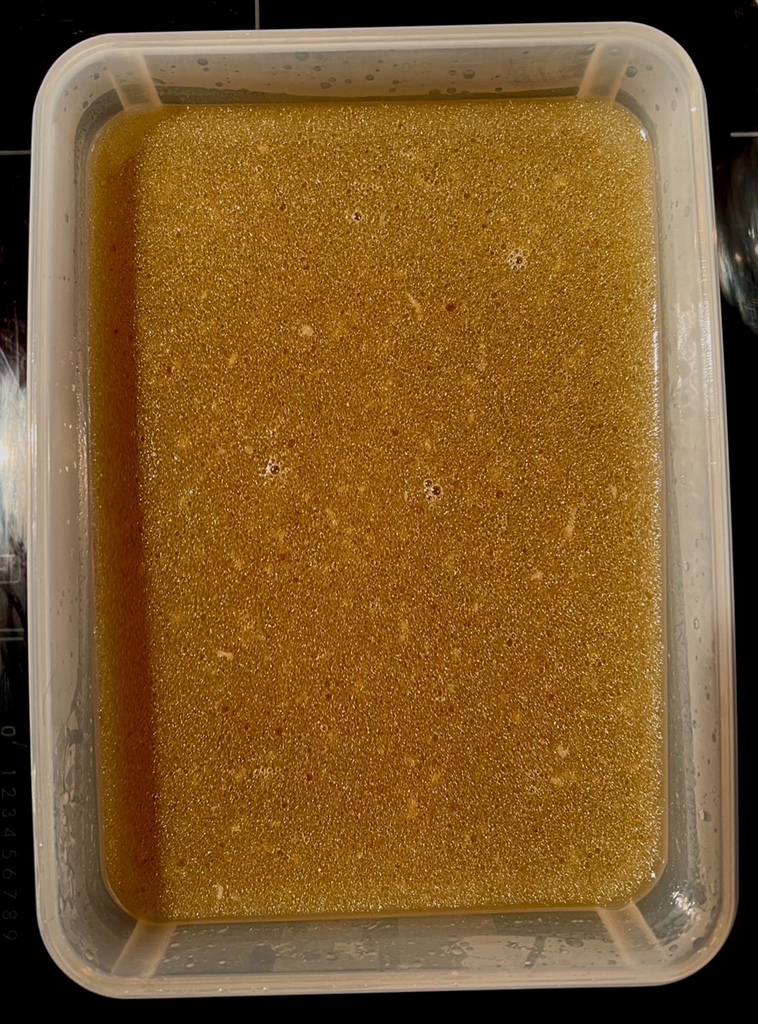
We now leave this stock to cool down completely. We do this in a sealed container in the refrigerator overnight.
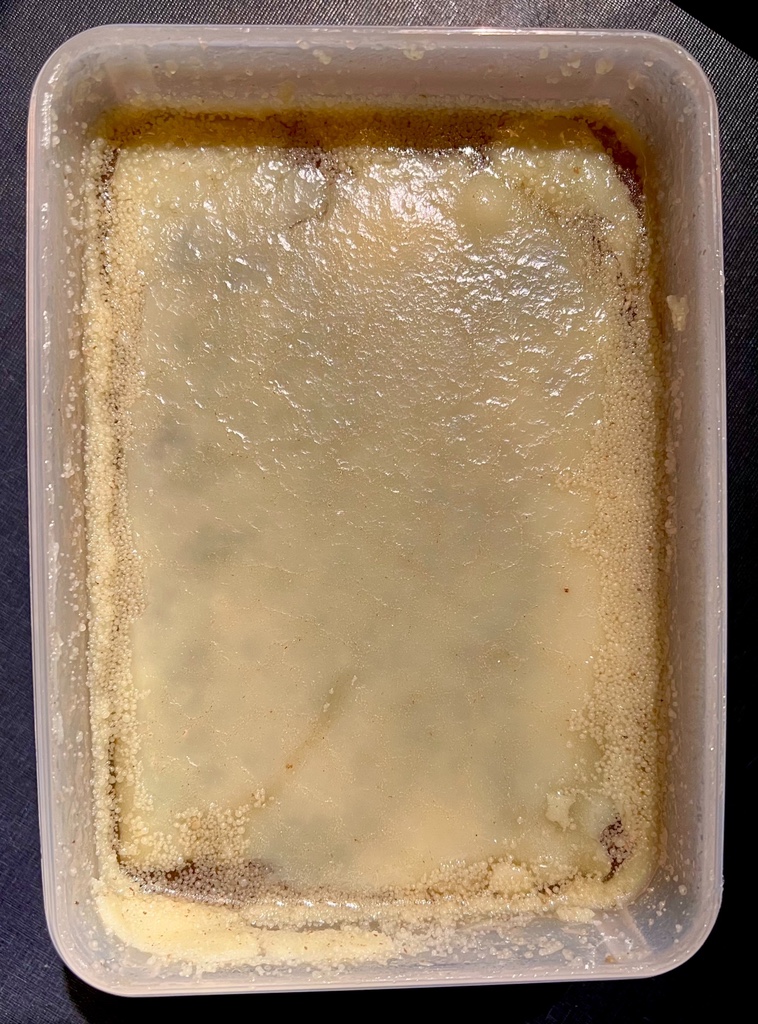
The fat is now on top and has solidified. If you have used a lot of bones, as we have, the stock underneath will have gelatinized like a wobbling pudding.
We remove the fat with a spoon. It is no longer usable.
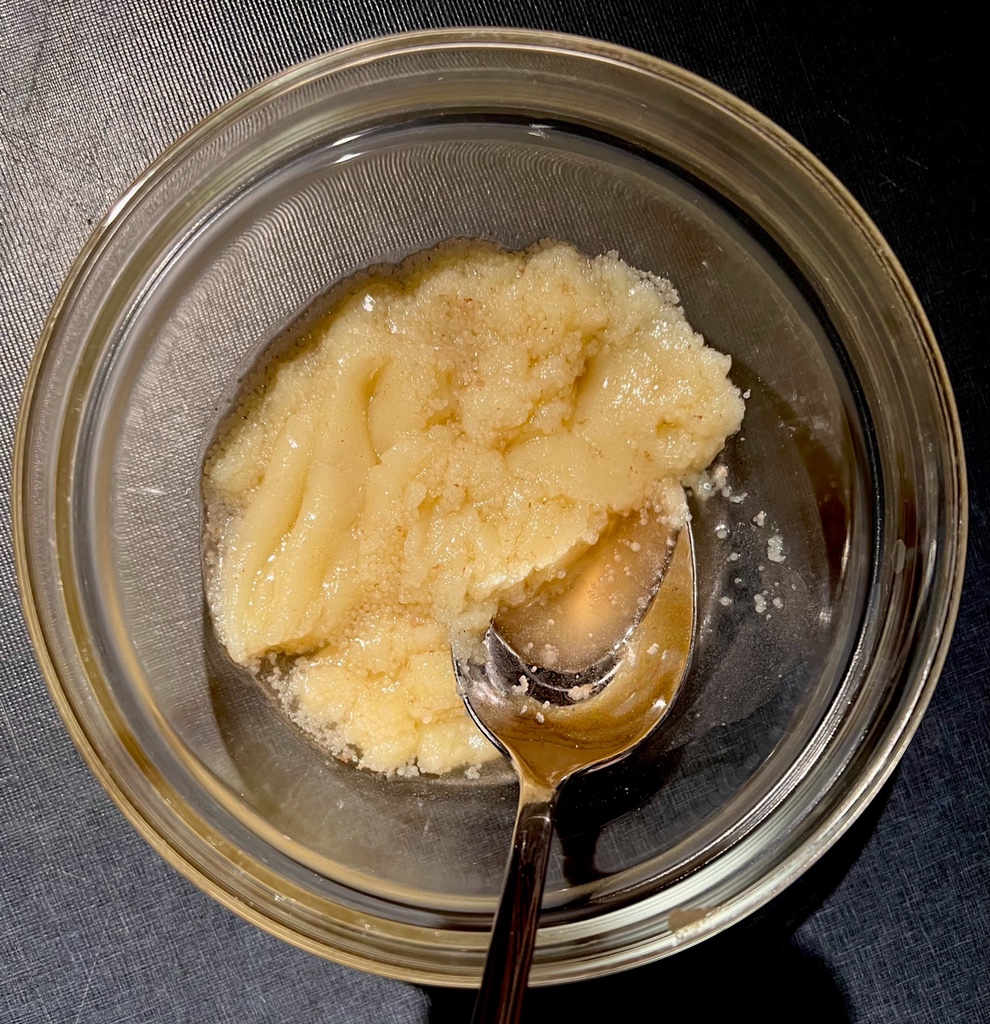
We want a consommé double, i.e. a double stock. For this we use the other half of the soup vegetables, i.e. celery, carrots and the rest of the leek. This time, however, the celery and carrots need to be finely grated.
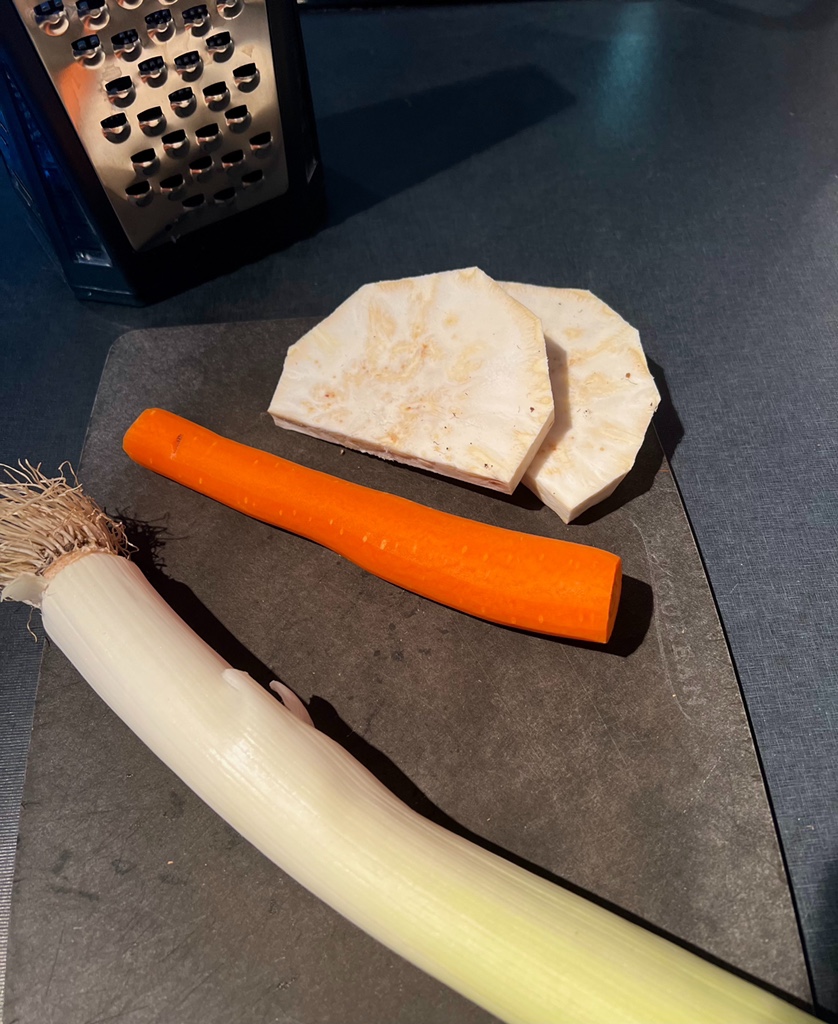
Pro-tip: Working with a grater can hurt as much as pissing off a cat. For little money you can buy a safety glove like the ones butchers use:
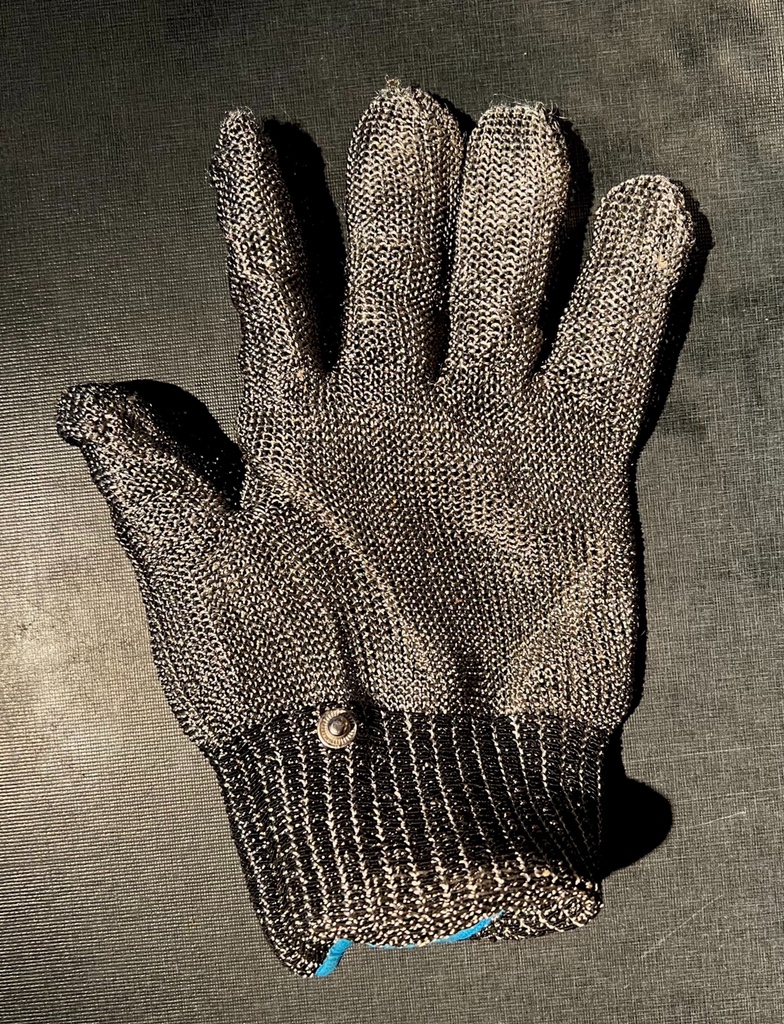
Cut the leek into small pieces with a knife and put all the vegetables into a pot.
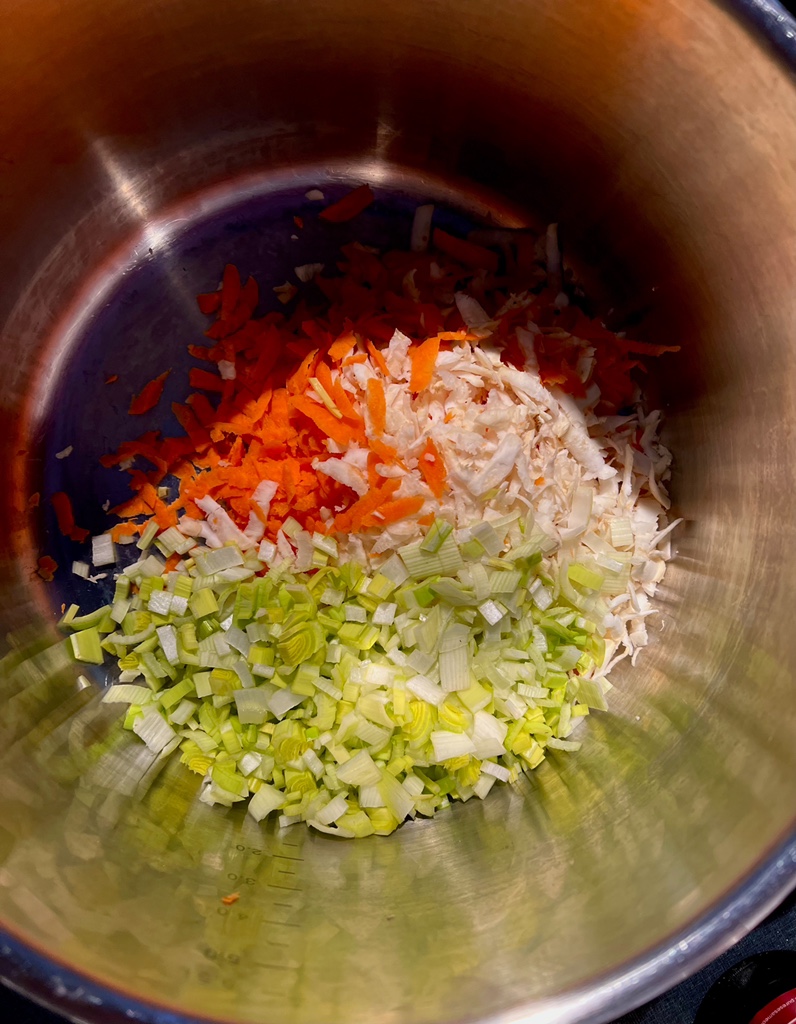
Now add 400 g of minced beef and the whites of 4 eggs (we use the yolks for making pasta).
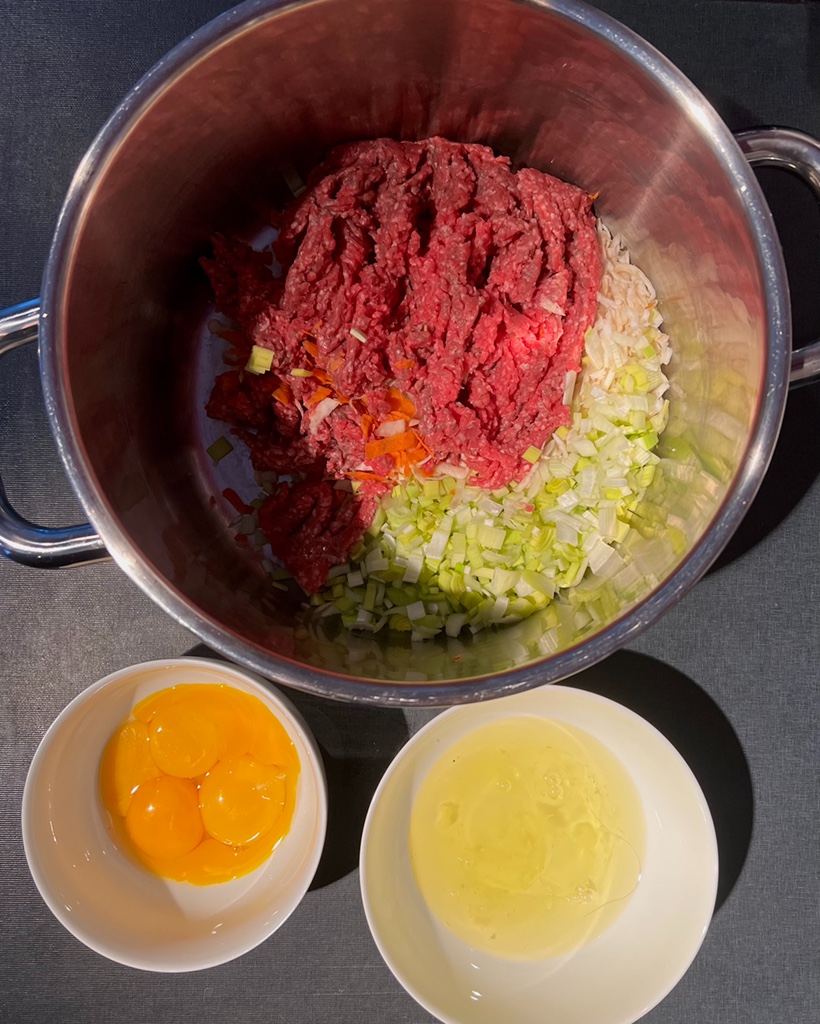
Now mix everything together well. Then add your (jellied) stock from the day before.
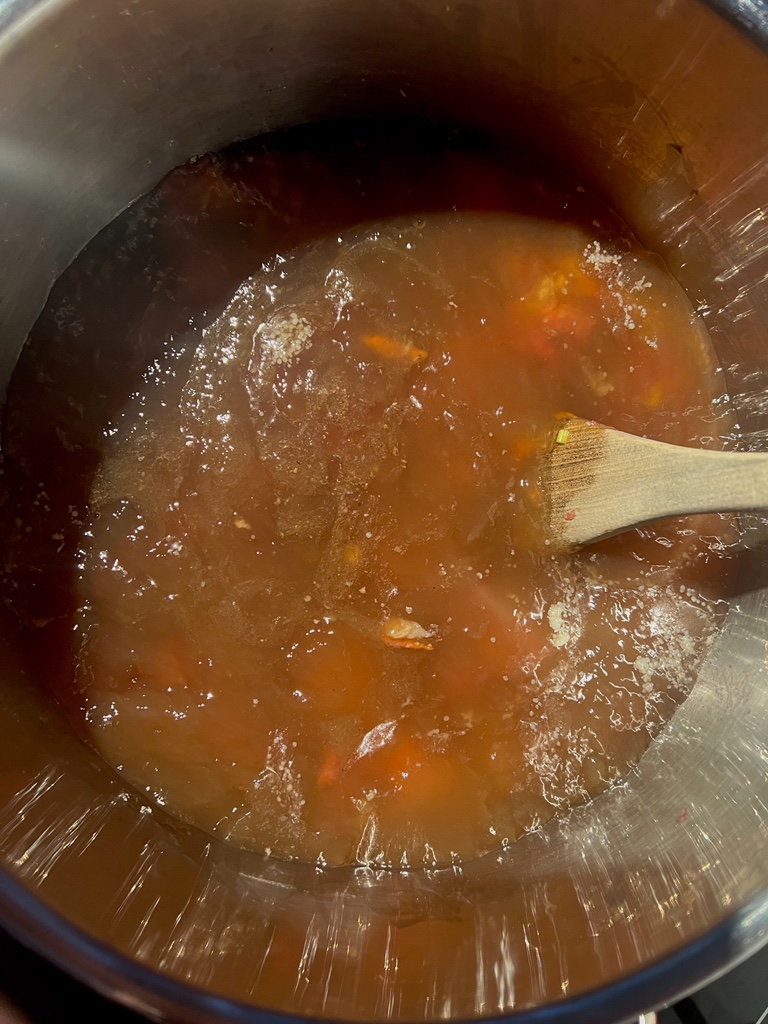
Meanwhile, use a spatula with a straight end to stir steadily and slowly at the bottom of the pot – otherwise the delicious product could burn because of the egg white!
As soon as the broth starts to boil, all the solids float to the top and foam forms on the surface. The liquid underneath breaks through the lid formed by the vegetables, meat and egg.
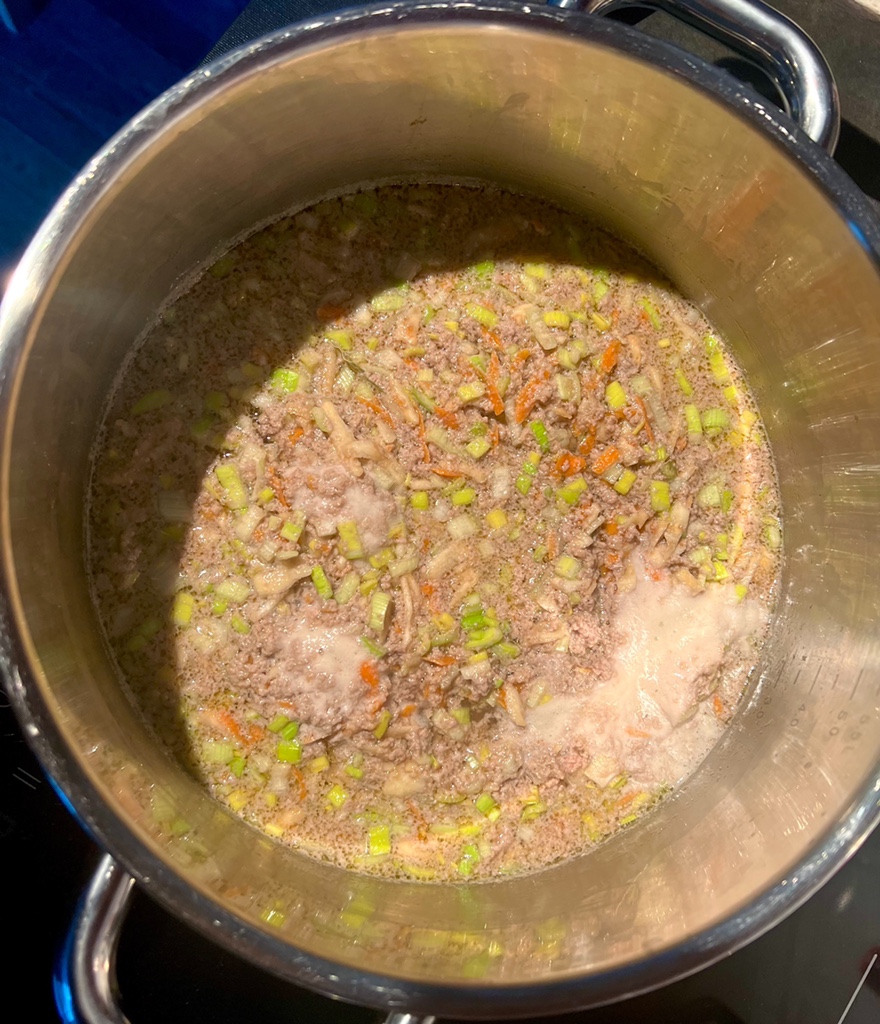
Once this happens, turn off the heat and DO NOT STIR AGAIN.
Leave to cool and infuse for at least 30 minutes.
Then you can remove the solid mass with a skimmer or a spoon. It is no longer usable, all the flavours have been extracted. The double stock underneath is crystal clear and golden.
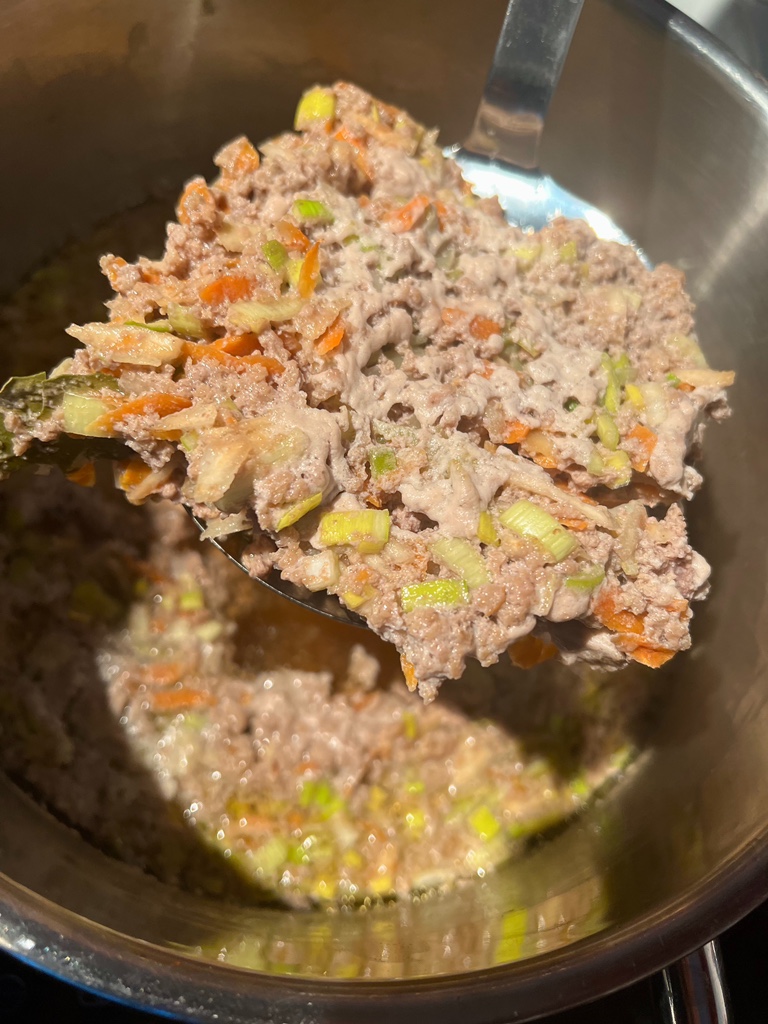
To obtain the consommé in its purest form, pour the rest through a fine sieve with a clean straining cloth.
Now you can carefully add salt, a little at a time, until you reach your desired result.
The result is liquid gold on the spoon. We refined it by infusing it with some fresh tarragon for a few minutes to add a touch of extra flavour, but that was just a bit of fun.
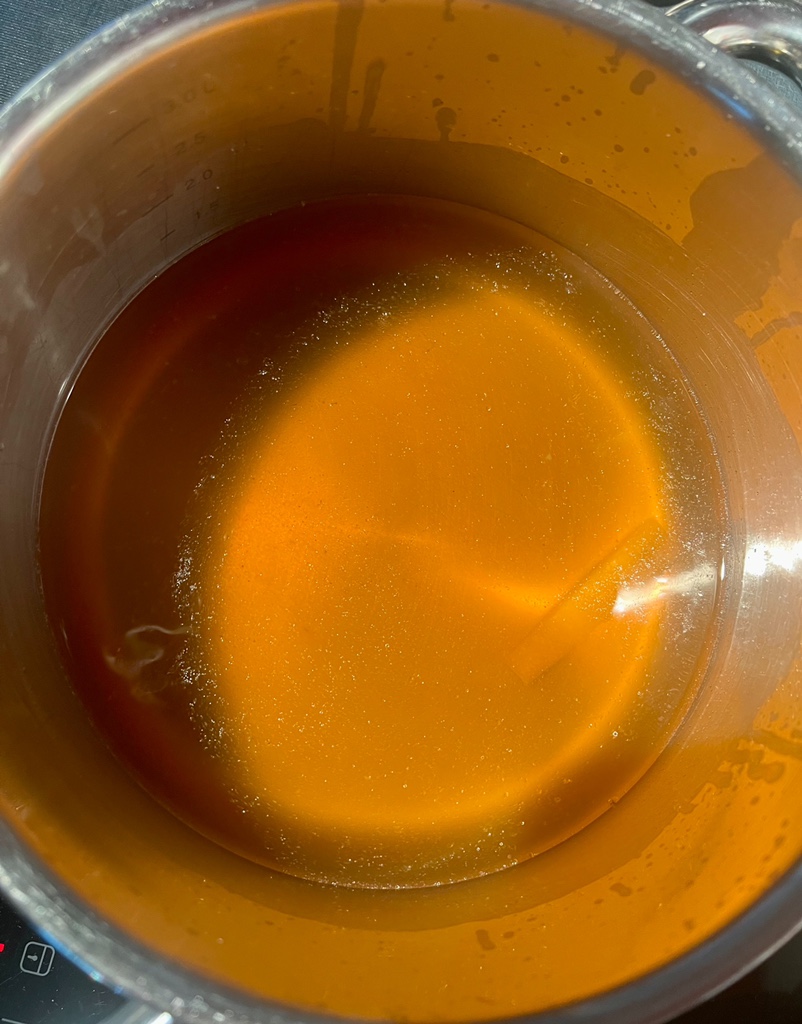
On the right side of the pot you can see a small, old Parmesan rind that we let float in the consommé until serving. This is completely optional.
Pro-tip: Never throw away the Parmesan rind. It can be kept in the fridge almost forever and is a miracle of umami.
Finally, you can finish the consommé with a splash of sherry.
Yes, the whole thing is a bit complicated. But only for the first time.
If you try it, you will be rewarded. Not only with the resulting dish, but with learning fundamental cooking techniques that will improve every of your dishes.
Enjoy.
And may the taste be with you.
Ingredients (for 1 litre):
1 kg meat bone from beef
400 g beef shank (alternatively: oxtail)
Celery, carrots and leek, 400 g each
1 onion
Spices: Bay leaf, peppercorns (optional: juniper berries, coriander seeds, dried mushrooms…)
4 eggs (we only need the egg white)
400 g minced beef
Optional: a little sherry
Time and patience
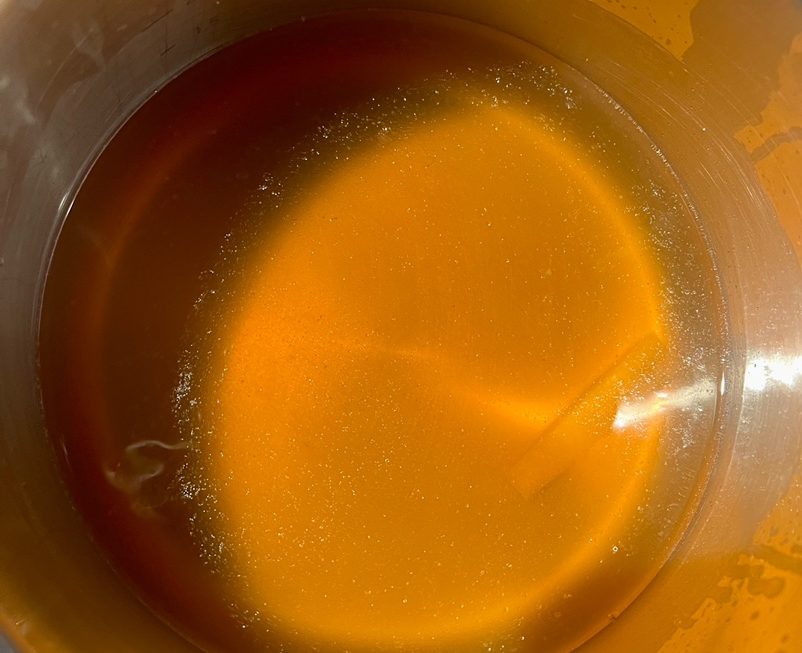
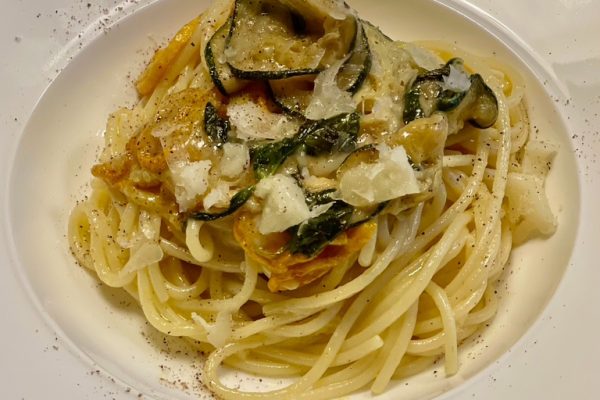
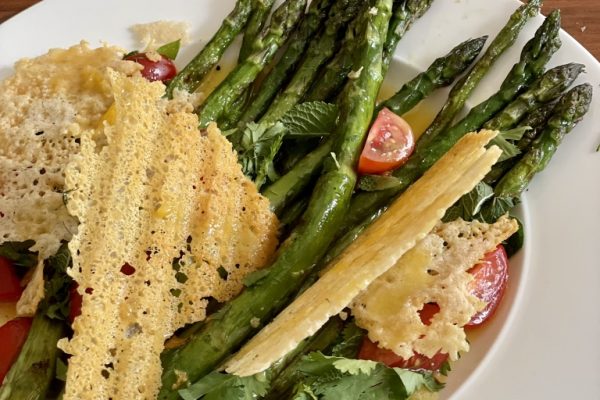
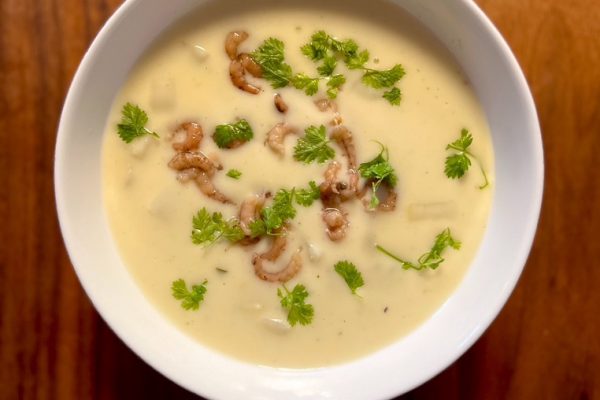

4 thoughts on “Consommé Double”